Discover 35 hidden attractions, cool sights, and unusual things to do in Minsk (Belarus). Don't miss out on these must-see attractions: Belarusian Great Patriotic War Museum, Minsk Zoo, and Minsk Hero City Obelisk. Also, be sure to include October Square in your itinerary.
Below, you can find the list of the most amazing places you should visit in Minsk (Minsk).
Table of Contents
Belarusian Great Patriotic War Museum
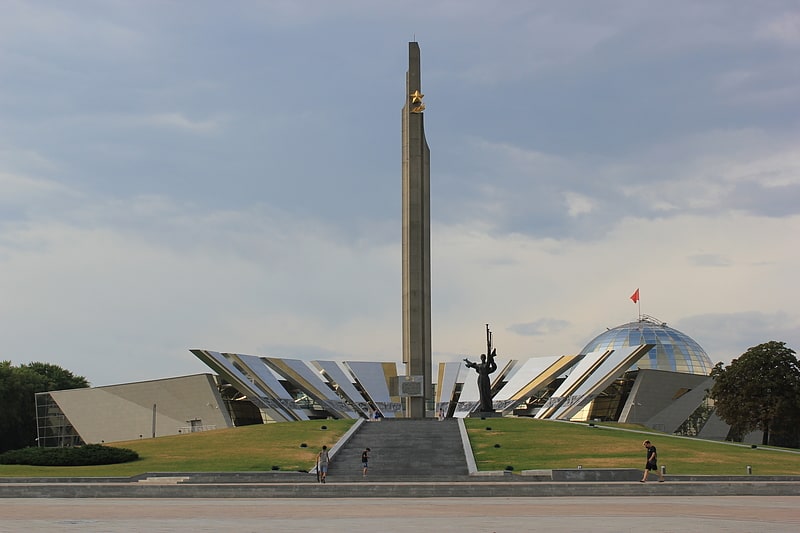
Also known as: Беларускі дзяржаўны музей гісторыі Вялікай Айчыннай вайны
Museum with World War II exhibits. The Belarusian Great Patriotic War Museum is a museum in Minsk, Belarus.
The conception of a museum commemorating the Great Patriotic War after the end of Nazi occupation sprung up even before the close of the war. The museum first opened shortly after the liberation of Minsk from the Nazi invaders, on 25 October 1944, making it the first World War II museum to open during the course of the war. It moved to its current location in 2014.
The museum has 24 exhibition halls. As of 2012 there were 142,676 items in the museum's collection.
The museum staff also engages in historical research: particular areas include Belarusians in the Red Army, local anti-fascist and partisan activity, and the history of the Auschwitz death camp.[1]
Address: Prospekte Pobeditelei 8, Minsk
Minsk Zoo
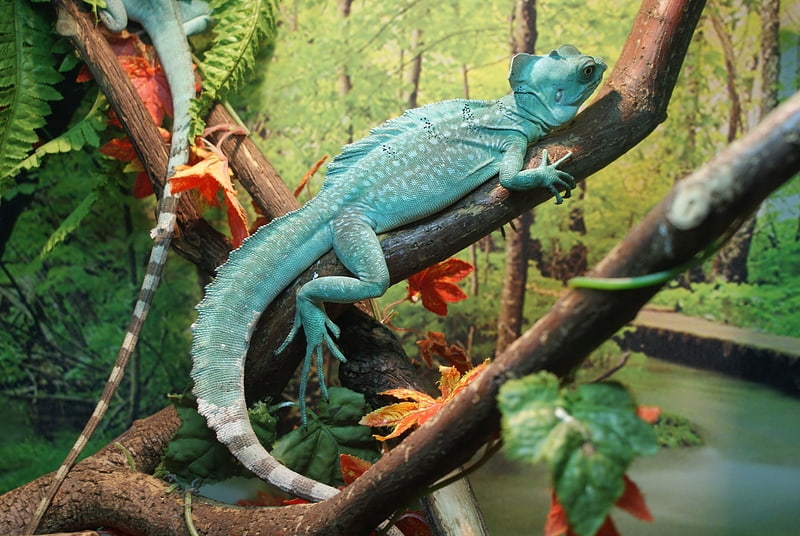
Also known as: Мінскі заапарк
Zoo with native and global animals. Minsk Zoo is located in a southeast part of Minsk near Svislach River.[2]
Address: Tashkentskaya 40, 220066 Minsk
Minsk Hero City Obelisk
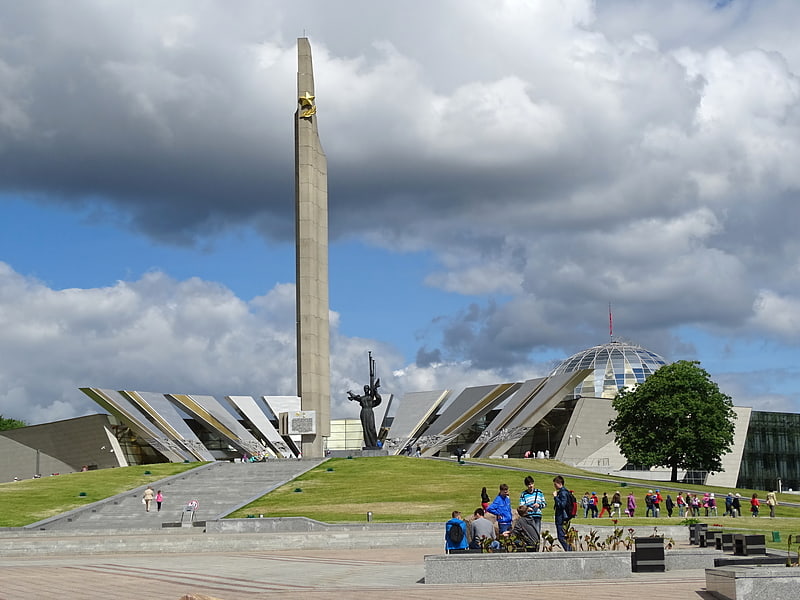
Minsk Hero City Obelisk is a 45 meters tall monument in the shape of an obelisk located on the Victors Avenue in Minsk, Belarus. The Obelisk is dedicated to the fact that Minsk was declared a Hero City on 26 June 1974 for its people's bravery during the Nazi occupation that lasted for 1,100 days. The Obelisk was opened in 1985 commemorating the 40th anniversary of victory in the Great Patriotic War.[3]
October Square

Also known as: Кастрычніцкая плошча
October Square is a square in the center of Minsk, Belarus, which is located between Independence Avenue, Engels streets and International Street. To its east side there are areas limited to buildings of the Palace of Culture of Trade Unions, the Museum of the Great Patriotic War and the Minsk Palace of Republic. Around the Square is the Central House of Officers, the residence of the President of Belarus, and the Janka Kupała National Academic Theater. On the square there are the main metro stations in Minsk: Kastryčnickaja and Kupawaŭskaja.[4]
Minsk-Arena
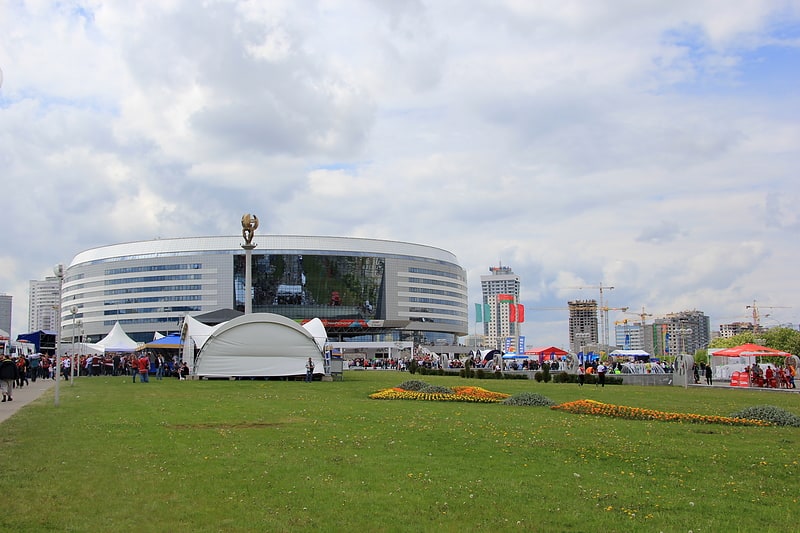
Also known as: Мінск-Арэна
Arena in Minsk, Belarus. Minsk Arena is the main indoor arena in Minsk, Belarus.
The Minsk-Arena complex includes four venues which are the arena itself (hosting 15,000 spectators), a cycling track (hosting 2,000 spectators), and a skating stadium (3,000 spectators).[5]
Address: просп. Победителей, 111, 220000 Мінск
Church of Saints Simon and Helena

Also known as: Касцёл Святога Сымона і Святой Алены
Historic red Catholic church with mass. The Church of Saints Simon and Helena, also known as the Red Church, is a Roman Catholic church on Independence Square in Minsk, Belarus.
This neo-Romanesque church was designed by Polish architects Tomasz Pajzderski and Władysław Marconi. The cornerstone was laid in 1905 and the church was completed in 1910. The bricks for its walls were sourced from Częstochowa, whilst the roof tiles came from Włocławek. Its construction was financed by Edward Woyniłłowicz (1847-1928), a prominent Belarusian-Polish landowner, businessman and civic activist. The church was named and consecrated in memory of Woyniłłowicz's two deceased children, Szymon and Helena.[6]
Address: Sovetskaya 15, 220030 Minsk
Cold Synagogue
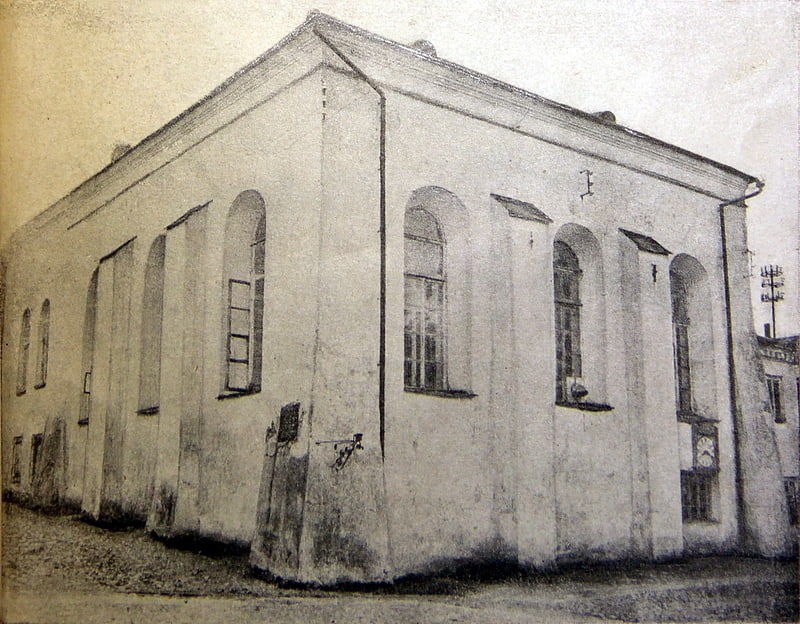
Synagogue. The Cold Synagogue was a masonry synagogue located in the center of Minsk on what is now Niamiha Street. It was not used as a place of study and therefore was not heated, which is why it received the name "Cold". The synagogue is considered the oldest in Minsk.[7]
Victory Square
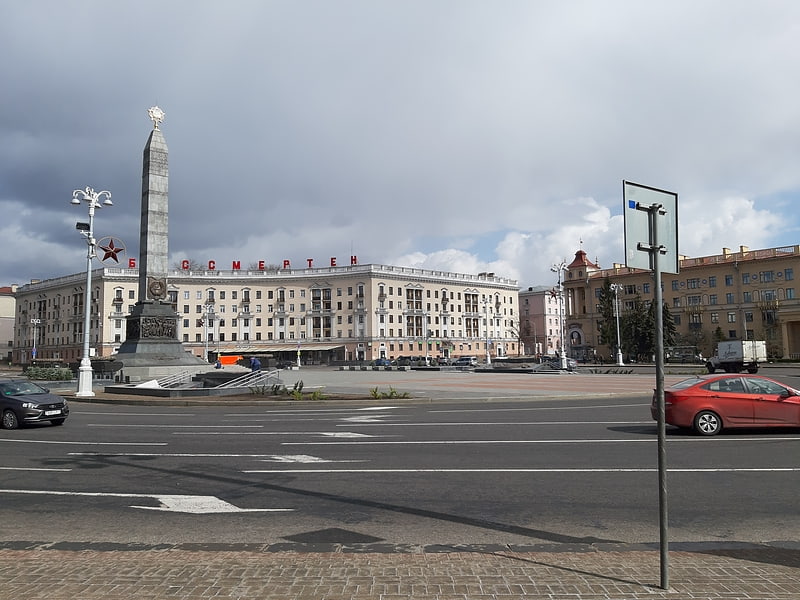
Also known as: Плошча Перамогі
Victory Square is a square in Minsk, Belarus, located at the crossing of Independence Avenue and Zakharau Street. The square is located in the historic centre of Minsk with the Museum of the 1st Congress of RSDLP, the main offices of National State TV and Radio and the City House of Marriages nearby. A green park stretches from Victory Square to the Svislach River and to the entrance to Gorky Park. Victory Square is the key landmark of Minsk, and holiday parades go through the square, while newlyweds traditionally take their picture at the square.[8]
Čyžoŭka-Arena

Also known as: Чыжоўка-Арэна
Arena in Minsk, Belarus. Čyžoŭka-Arena is a multi-purpose indoor arena in Čyžoŭka microdistrict of Minsk, Belarus. Its full name is "Шматфункцыянальны культурна-спартыўны і забаўляльны комплекс «Чыжоўка-Арэна»".
Opened in December 2013, it is mostly used for concerts, ice hockey and other indoor sporting activities. The main arena has a capacity of 8,807 people and the training arena has 473 seats. The project of Čyžoŭka-Arena was changed several times. The final project was approved in 2010.[9]
Address: Tashkentskaya 19, 220077 Minsk
St Elisabeth Convent
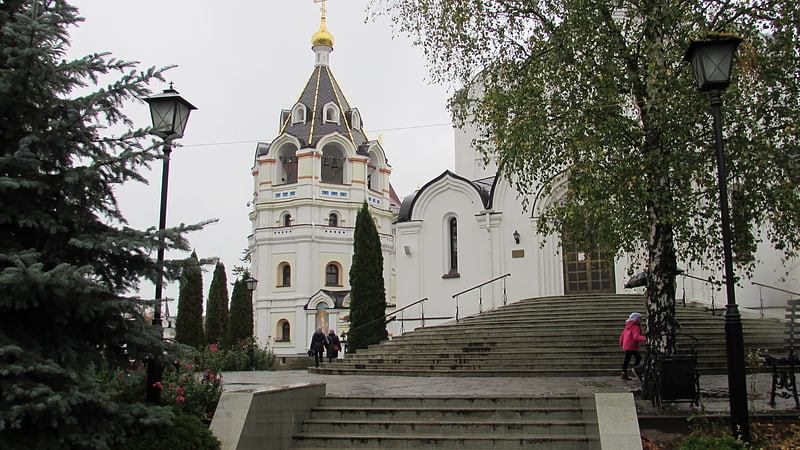
Convent in Minsk, Belarus. St Elisabeth Convent is an Orthodox convent on the outskirts of Minsk, Belarus. Currently, it is the only functioning monastery in the city.[10]
Museum of Jewish History and Culture in Belarus

Museum of Jewish History and Culture in Belarus is a small museum in Minsk, Belarus. It was founded in 2002 by historian Inna Gerasimova in conjunction with the American Jewish Joint Distribution Committee. The Joint Committee still financially supports it, along with the local Belarusian Jewish community. Offices for local Jewish community services are located in the same building, on the Minsk Jewish campus.
The museum, despite lacking accreditation and an advisory board, is nonetheless working to preserve the memory of the early Jewish communities in Minsk and narrate their story during World War II. Besides exhibits, the museum staff also conducts outreach and educational programs, such as public forums and the "Righteous Among the Nations" program (which honors non-Jews who worked to help the Jewish community). Nearby the museum is Zaslaŭski Memorial, the site of at least one mass murder of Jewish citizens.[11]
National Opera and Ballet of Belarus
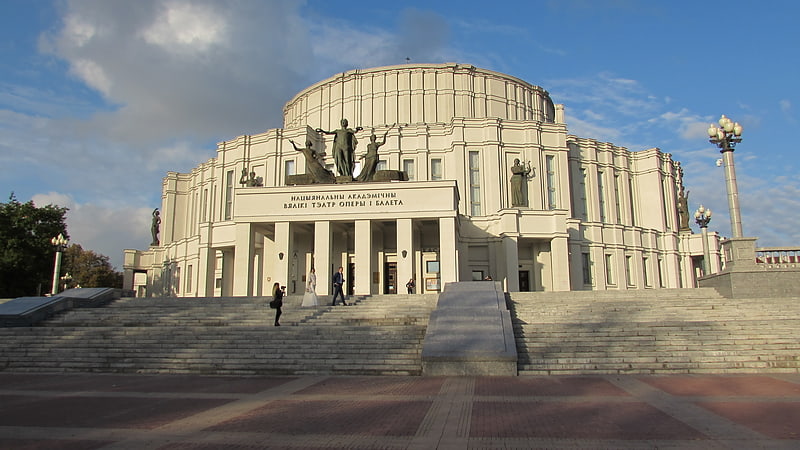
Also known as: Нацыянальны акадэмічны Вялікі тэатр оперы і балета
Theatre in Minsk, Belarus. The National Academic Grand Opera and Ballet Theatre of the Republic of Belarus is located in a park in the Trinity Hill district of Minsk. Local people call it the "Opierny Teatr" or the "Opera and Ballet Theatre." While the theatre opened on 15 May 1933, in the beginning, it did not have its own performance venue. Until 1938, the troupe performed at the Belarusian Drama Theatre building.[12]
Address: Parizhskoy Komunny 1, 220029 Minsk
Gorky Park
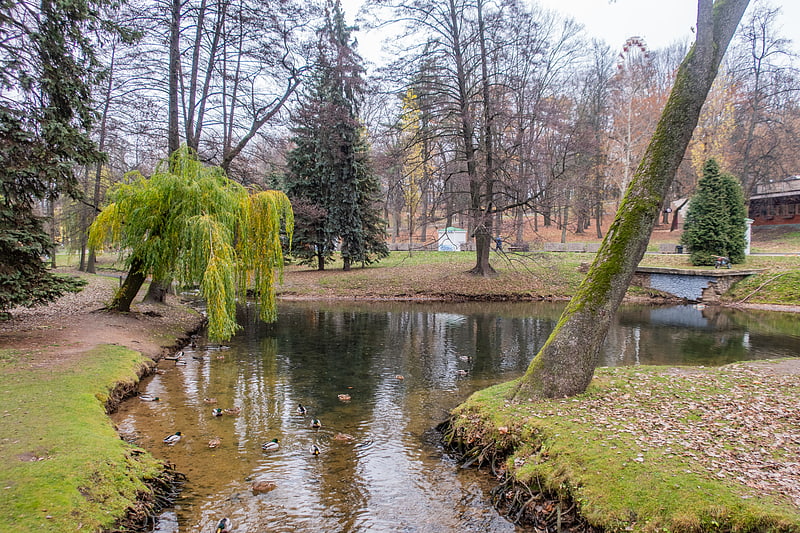
Also known as: Цэнтральны дзіцячы парк імя Максіма Горкага
Amusement park in Minsk, Belarus. Gorky Park is a public park in Minsk, Belarus.
It is located near the Victory Square and the Yanka Kupala Park.
The park was established in 1800 under the name Governor's Garden. During the Soviet times it was renamed "парк культуры і адпачынку імя Максіма Горкага" (Park of culture and recreation after A.M. Gorky) after the famous Russian/Soviet writer Maksim Gorky. Parks with this name have been established in many cities of the Soviet Union.
A part of the park's territory is occupied by an amusement park with a 56-meter-high (184 ft) Ferris wheel. It also has an educational observatory with planetarium.
The Ice Palace (indoor skating rink) is also located in Gorky Park. President Lukashenko, known for his hobby of ice hockey, frequents this place, at which times the access to this part of the park is closed for general public.[13]
Address: ул. Фрунзе, 2, Minsk
Belarusian National History Museum
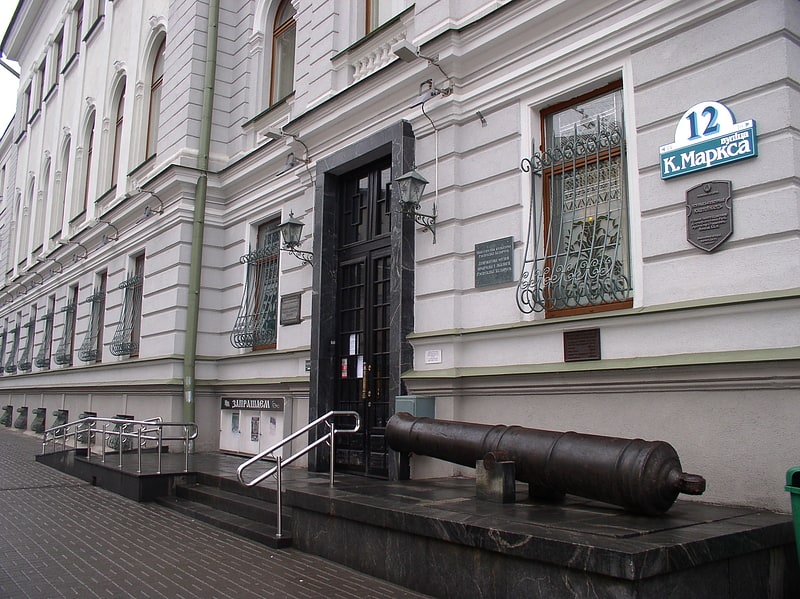
Also known as: Нацыянальны гістарычны музей Рэспублікі Беларусь
Museum for Belarusian culture and history. Belarusian National History and Culture Museum is a museum in Minsk, Belarus.
The leading Museum of the historic profile of the Republic of Belarus is the biggest collection of the monuments of material and spiritual culture of the Belarusian people from the ancient times to modern day. It contains around 370,000 artefacts. Chronological frames of the museum fund are from 40,000 B.C. to present time. Several collections of the museum are of special value:
- The biggest archaeological collection in Belarus
- Collection of materials on the history of primeval society including hunting, fishing, and agricultural instruments, domestic and ritual articles, ancient works of art and adornment
- Manuscripts and block letter books
- Collection «Belarusian folk costume» features both everyday and festal, ceremonial Belarusian clothes; there are costumes of different age and social groups of population
- Numismatics collection
- Exposition «The ancient Belarus»
- Exposition «Old heraldry of Belarus». Practically all the exhibits of the exposition are presented to the public for the first time. The authors of the exhibition tried to personify the heraldry and tell about the carriers of heraldic traditions.
The museum was established in 1957 as a museum of local lore, history, and economy. In 1991 it was reorganized to the National museum. In 1967, the museum was opened for visitors. At present, approximately 100,000 visitors attend the museum annually.[14]
Address: ул. Карла Маркса, 12, 220030 Мiнск
Holy Spirit Cathedral

Also known as: Кафедральны сабор Сашэсця Святога Духа
Orthodox church in Minsk, Belarus. The Holy Spirit Cathedral is a temple in Minsk, Belarus, consecrated in honor of the Holy Spirit, the central cathedral of the Belarusian Orthodox Church. It was built in 1633–1642 as a part Bernardine monastery during the Polish–Lithuanian Commonwealth in a place of former men Orthodox monastery, then was returned to the Orthodox again in 1860. The cathedral is listed as a Belarusian Cultural heritage object and is considered one of the main landmarks in Minsk Upper city.[15]
Address: Kirilla I Mefodiya 3, 220030 Minsk
Cathedral of the Holy Name of Saint Virgin Mary
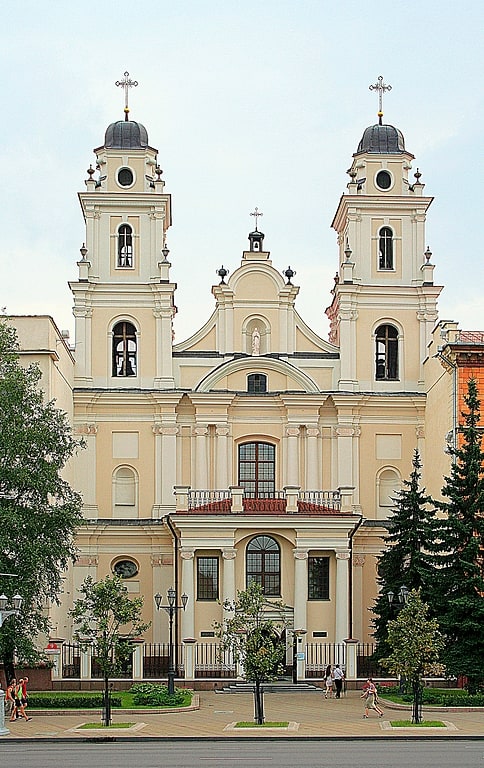
Also known as: Архікафедральны касцёл Імя Найсвяцейшай Дзевы Марыі
Catholic cathedral in Minsk, Belarus. Cathedral of the Holy Name of Mary is a Roman Catholic baroque cathedral in Minsk. It is the seat of the Roman Catholic Archdiocese of Minsk-Mohilev.
It was built under the Polish rule in 1710 as a church for the Jesuit house. In 1793, after the Russian conquest of Belarusian part of the Polish–Lithuanian Commonwealth, the Jesuit order was banned and the church got a local status. Soon, after creation of the Minsk diocese, the church became the local cathedral.
The Cathedral was heavily damaged in a fire in 1797, but was later fully renewed. In 1869, the Minsk diocese was liquidated and the church got a parafial status. In November 1917, the diocese was restored; Zygmunt Lazinski was appointed as a bishop.
In 1920, Lazinski was arrested by Soviet authorities, the cathedral was closed down in 1934.
During the Second World War, the Germans allowed the cathedral to function again, but after the war it was again closed down by the Soviets. In 1951, the cathedral's bell towers were intentionally destroyed by Soviet artillery and the building itself was given to the Spartak sports society.
In the beginning of the 1990s, religious services started again. In 1993, the building was given back to the Roman Catholics; by 1997 it had been renovated.
In 2005, the church was given a new organ manufactured in Austria. Around the same time, the frescoes created in the 18th century were also restored.[16]
Address: Svobody 9, 220030 Minsk
Yakub Kolas Square
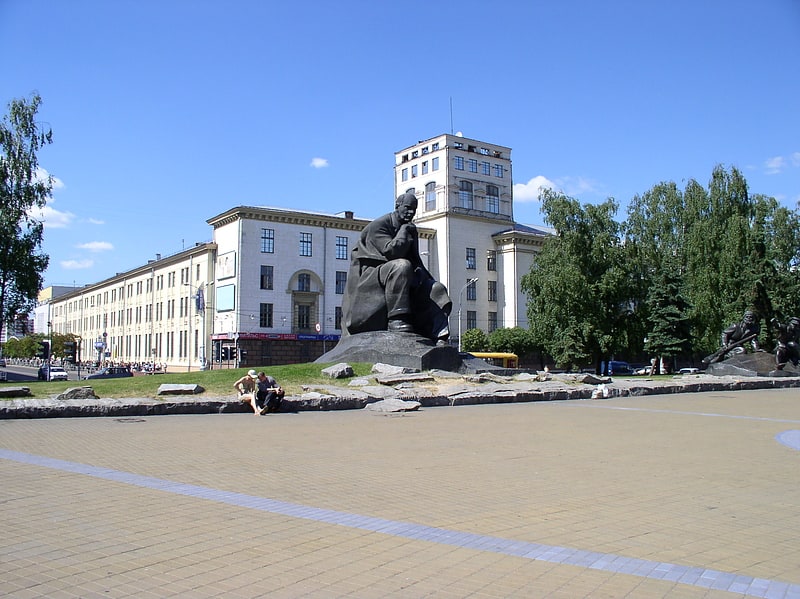
Also known as: Плошча Якуба Коласа
The Yakub Kolas Square is a square in Pershamayski District of Minsk, located on the crossing of Independence Avenue, Yakub Kolas street and Vera Khoruzhaya street. The square was named in honour of the folk poet and one of the founders of the classic Belarusian literature - Yakub Kolas.[17]
Church of Holy Trinity
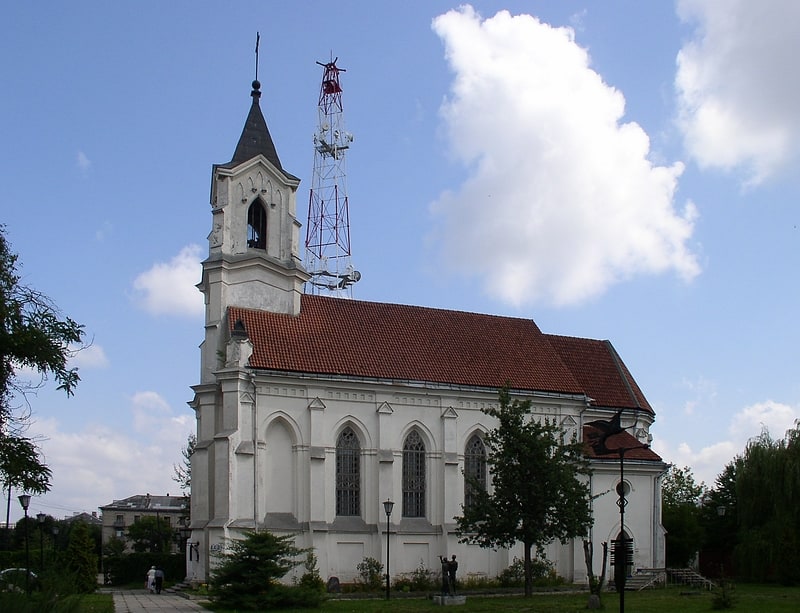
Also known as: Касцёл Святой Тройцы на Залатой Горцы
Catholic church in Minsk, Belarus. Church of Holy Trinity also known as St. Roch on the Golden Hill is a Roman Catholic church in Minsk. In the 1930s, the church was closed and the valuables removed by the Soviet authorities. Renovation of the church started in 1983.[18]
Address: Čyrvanazornaja vulica 44/А, Minsk
Independence Square
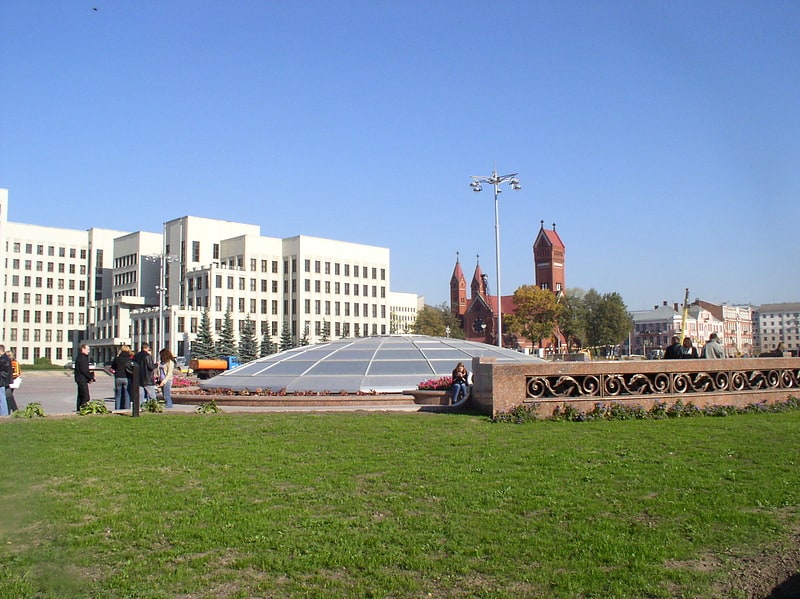
Also known as: Плошча Незалежнасці
Transit station in Minsk, Belarus. Independence Square is a square in Minsk, Belarus. It is one of the landmarks on Independence Avenue. The National Assembly of Belarus and Minsk City Hall are on this square. During the period of the Byelorussian Soviet Socialist Republic it was called Lenin Square. It is currently one of the largest squares in Europe.[19]
Belarusian National Arts Museum
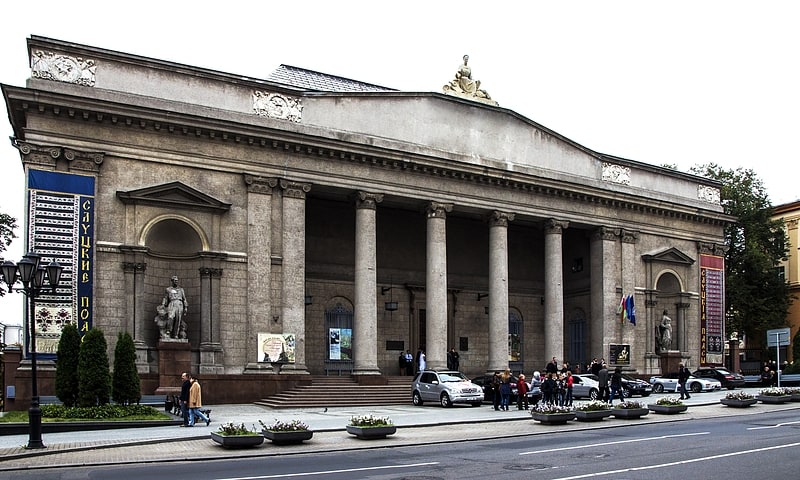
Also known as: Нацыянальны мастацкі музей Рэспублікі Беларусь
Art museum in Minsk, Belarus. The National Art Museum of the Republic of Belarus is the largest art museum in Belarus and is located in Minsk. The museum comprises more than thirty thousands works of art which make up twenty various collections and constitutes two main ones: the one of national art and the other of art monuments of various countries of the world.[20]
Address: Vulitsa Lenina 20, Minsk
Yanka Kupala National Academic Theatre

Also known as: Нацыянальны акадэмічны тэатр імя Янкі Купалы
Theatre in Minsk, Belarus. Yanka Kupala National Academic Theatre is the oldest existing theatre in Belarus. It is included in the list of the cultural heritage of Belarus.[21]
Address: Minsk, Vulica Enhieĺsa 7, Minsk 220030, Belarus
Yanka Kupala Park

Also known as: Парк імя Янкі Купалы
Park in Minsk, Belarus. Janka Kupała Park is a park in Minsk, Belarus located along Śvisłač river. This park is named after Janka Kupała, one of the classics of Belarusian literature of early 20th century.
Before World War II at this place there was the house of poet Janka Kupała. In 1959 the Janka Kupała's museum near the park was constructed that has at its disposal a big collection of autographs, photos, documents and poet's personal belongings. In 1972 a monument to Janka Kupała was built. In the park there is also a fountain called 'Vianok' (wreath).[22]
Maksim Bahdanovič Literary Museum
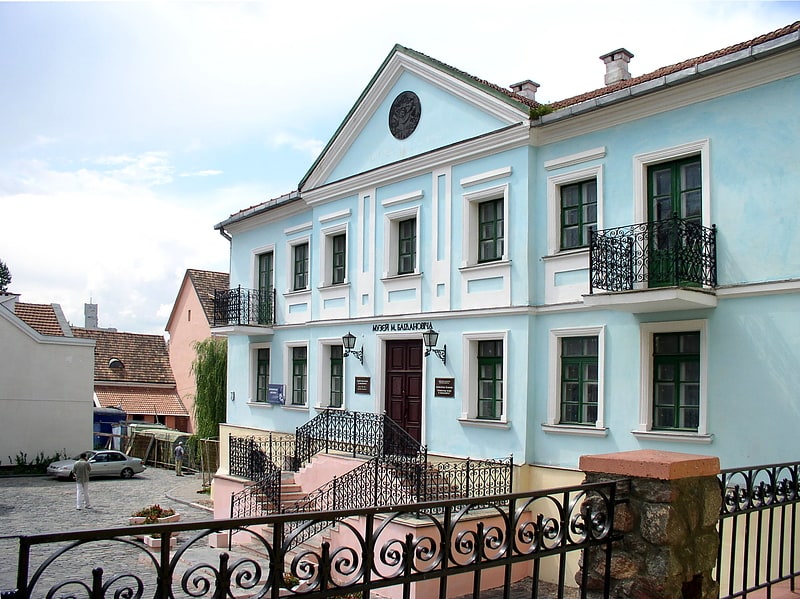
Also known as: Літаратурны музей Максіма Багдановіча
Museum. Maksim Bahdanovič Literary Museum is a museum in Minsk, Belarus. It is dedicated to the writer Maksim Bahdanovič. The work of the bibliographer Nina Vatatsy was central to the museum's foundation.[23]
Central House of Officers

Building. The Central House of Officers, also known as the Army Palace, is a former Red Army building which currently serves as the main cultural institution of the Belarusian Armed Forces built in 1939. It was one of the only buildings built by Soviet architect Losif Langbard that survived the war.
It presents historical education and promotes the moral readiness of the military by familiarizing servicemen and the general public. Events that fall under this task includes weddings, concerts, musical and theatrical performances, and lectures. The current Head of the Central House of Officers is Colonel Valeriy Kurda.[24]
National Library of Belarus
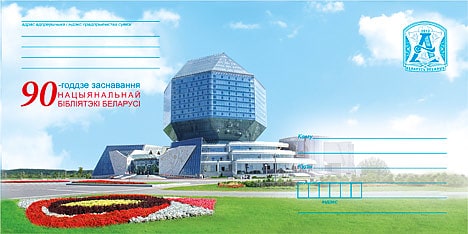
Also known as: Нацыянальная бібліятэка Беларусі
National library with an iconic design. The National Library of Belarus is the biggest library in the Republic of Belarus. The library is located in Minsk, the capital of Belarus. It houses the largest collection of Belarusian printed materials and the third largest collection of books in Russian behind the Russian State Library and the Russian National Library.[25]
Address: Nezavisimosti 116, 220114 Minsk
Ў gallery
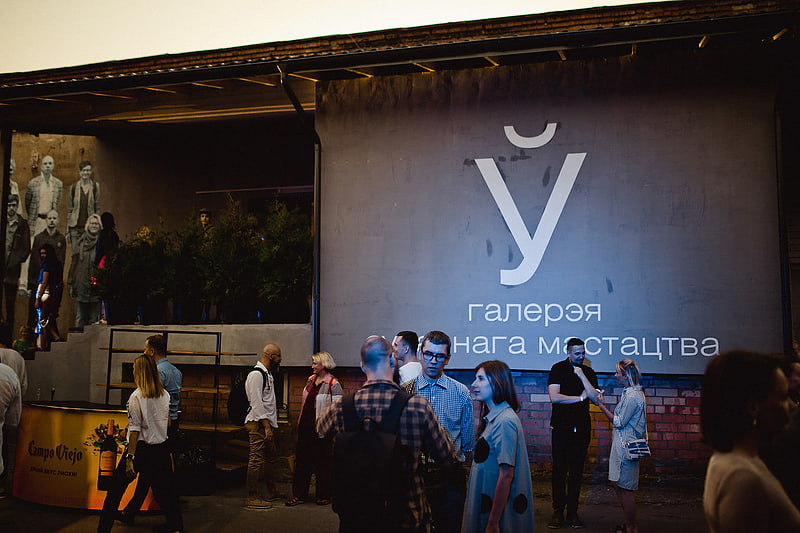
Also known as: Галерэя Ў
Art gallery in Minsk, Belarus. The Ў Gallery was an art gallery of contemporary art located in Minsk, the capital of Belarus. The Gallery Ў consised of the exhibition space, wine bar Ў, design-shop and Literary House Logvinov.[26]
Address: Kozlova St., 3, Minsk
Uručča

Also known as: Уручча
Uručča, is a microdistrict in the north-eastern part of Minsk. It was founded on the place of former Uručča village in the early 1980s. Uručča divided into six parts with corresponding numbers. The metro station of the same name was opened on November 7, 2007. It is the first station outside the Minsk Automobile Ring Road.
The following streets are in the neighborhood of Uručča : Rusijanava, Šuhajeva, Nikifarava, Šafarnianskaja, Haradzieckaja, Hintaŭta, Ložynskaja, Astrašyckaja, Uručskaja, Starynaŭskaja.[27]
Kalvaryja
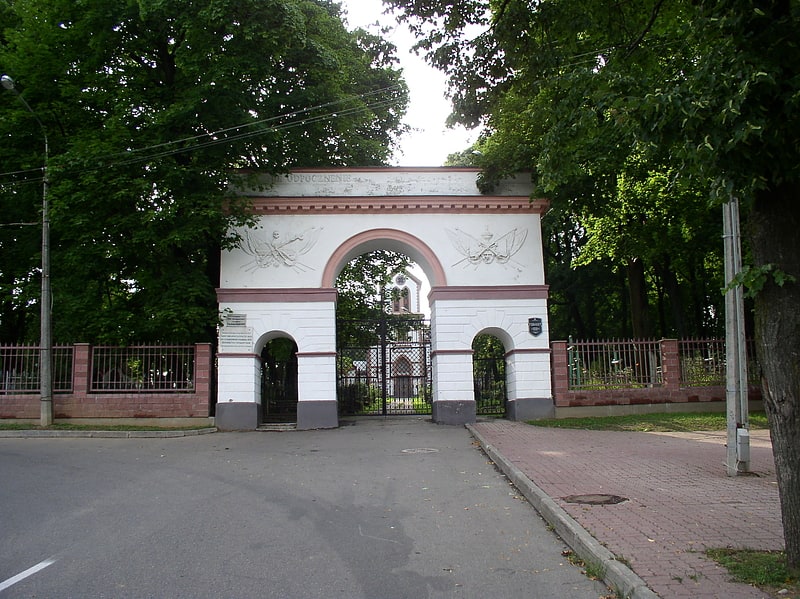
Also known as: Кальварыйскія могілкі
Cemetery in Minsk, Belarus. Kalvaryja is a Catholic Calvary cemetery in Minsk, Belarus.
The cemetery contains a small Catholic chapel, currently used for general worship. The original wooden Catholic church was first built here back in 1673, but currently the oldest remaining graves are from 1808. The small chapel was built in 1839. Several famous Polish and Belarusian personalities from the 19th century are buried at Kalvaryja.
In 2001, the cemetery became the center of a controversy when it was revealed that the state-run company responsible for taking care of the graves was quietly destroying old graves and selling the newly freed slots to the wealthy.[28]
Address: ул. Притыцкого, Minsk
Kalinin Square

Also known as: Плошча Калініна
Kalinin Square is the 5th square on the Independence Avenue of Minsk. The square was named in honor of the Soviet Head of State Mikhail Kalinin. The square started to form in 1953. The monument to Kalinin, located on the square, was built in 1978.[29]
Military Cemetery
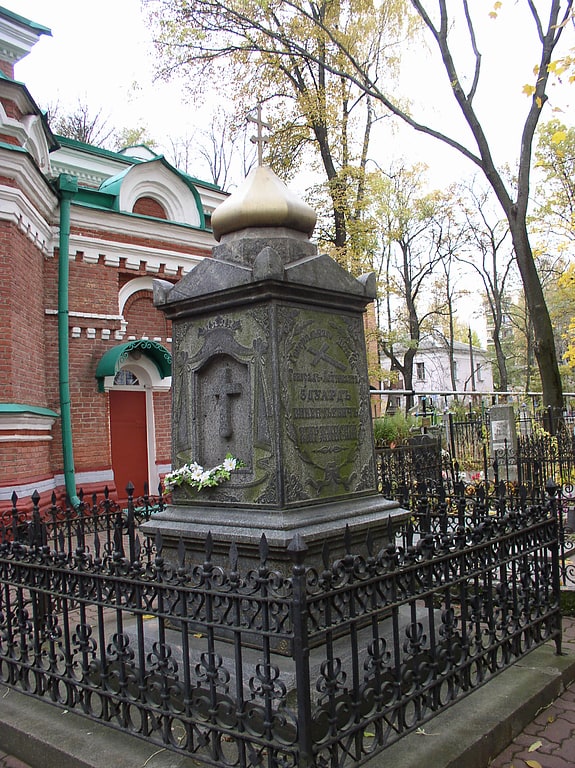
Also known as: Вайсковыя могілкі
Cemetery in Minsk, Belarus. Military Cemetery is a cemetery in Minsk, Belarus.[30]
Trinity Suburb
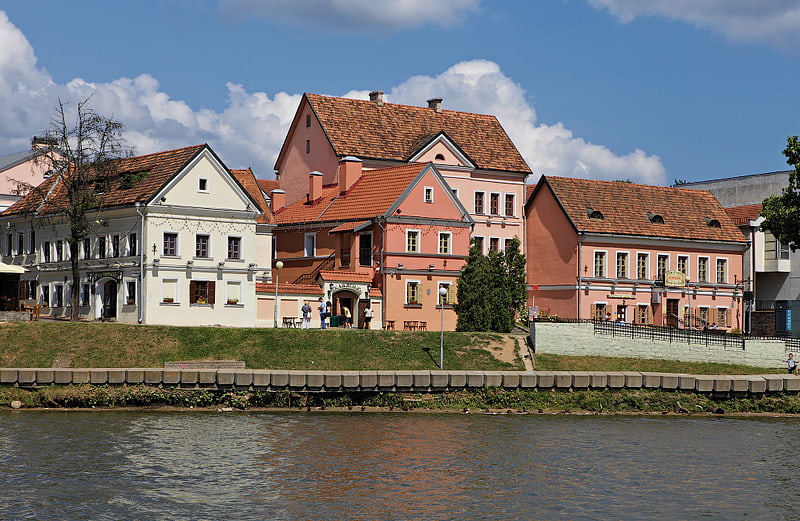
Suburb in Minsk, Belarus. The Trinity Suburb is a historical district of Minsk located in the north-eastern part of the historical centre on the left bank of the Svislach river. It was the trade and administrative centre of the capital of Belarus in the past. In the northwest of the Trinity Suburb there is Tatarskaya Slabada, settled by Lipka Tatars from the 15th century to mid-20th century, and Starastinskaya Slaboda, in the north - Storozhevka, in the east - Zolotaya Gorka, in the south - the central regions of the High and Low Markets.
The first Catholic church in Minsk was located on the territory of the suburb. There were also the Ascension Monastery with the church of the same name, which have not survived to this day, St. Boris and Gleb Church, the Basilian Convent of the Holy Trinity and the Church and Monastery of the Catholic monastic order. Nowadays the suburb is one of the most favorite places of Minsk residents and guests of the capital.
Modern buildings of the district include the National Opera and Ballet Theatre, the Island of Tears, memorial that commemorates the Soviet soldiers died in the Afghanistan war in the 1970s.[31]
Chelyuskinites Park

Also known as: Парк Чалюскінцаў
Amusement park in Minsk, Belarus. Chelyuskinetes Park or Park Čaliuskincaŭ is an urban forest park in Minsk, Belarus. The park's area is 78 hectares.
The park contains an amusement park. Other attractions include a Children's Railroad, operated exclusively by teenagers, and a cinema Raduga (English: rainbow). There is a Minsk Metro station "Park Čaliuskincaŭ" next to the park. The park is adjacent to the Minsk Botanical Garden.
The park was established during 1928-1932 as Kamaroúski Park and was renamed in 1934 for the crew of the SS Chelyuskin. It was based on the existing Kamaroúski Forest (Kamaroŭski lies), enriched by noble and decorative species of trees. Historically the park was part of the Wańkowicz family estate and was called the Wańkowicz Forest. According to the book "In the claws of the GPU" of the Belarusian writer Frantsishak Alyakhnovich, Kamaroúski Forest was the place of the regular executions of the prisoners of Minsk NKVD prison.[32]
Address: Prospekt Nezavisimosti, ~91, Minsk
State Flag Square
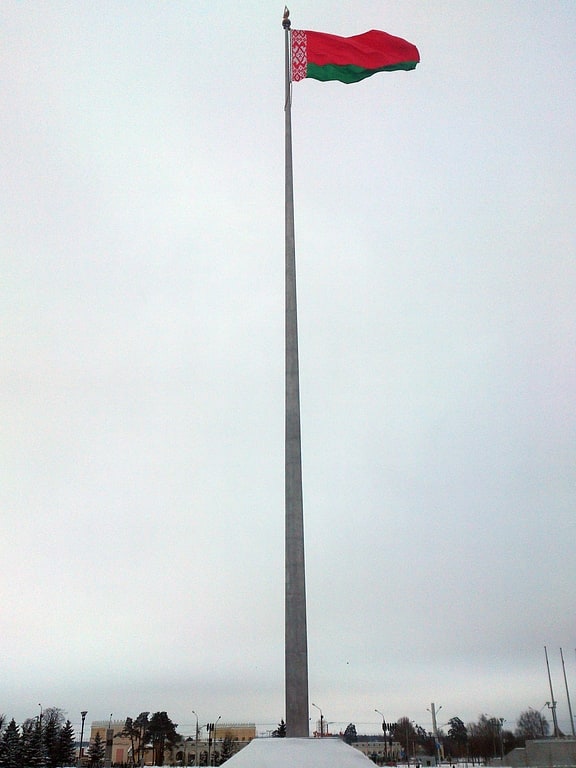
Also known as: Плошча Дзяржаўнага Сцяга
Tourist attraction in Minsk, Belarus. State Flag Square is a square on Victors Avenue in the city of Minsk, the capital of Belarus. It sits between the avenue and the BelExpo Exhibition Center.[33]
The Pit Memorial

Also known as: Яма
Sculpture. The Pit is a monument dedicated to the victims of the Holocaust on the corner of Melnikayte and Zaslavskaya streets in Minsk, Belarus. The memorial is located at the site where on March 2, 1942, the Nazi forces shot about 5,000 Jewish residents of the nearby Minsk Ghetto. The obelisk was created in 1947, and in 2000 a bronze sculpture titled "The Last Way" was added. It represents a group of victims descending the steps of the pit. The sculpture was created by the Belarusian artist and Chairman of the Jewish communities of Belarus, Leonid Levin, and the sculptor Elsa Pollak from Israel. On the obelisk is written in Russian and Yiddish, "To the shining memory of the bright days of five thousand Jews who perished at the hands of sworn enemies of humanity, German-fascist butchers, on March 2, 1942."
When the reconstruction of the memorial was undertaken, no machinery was used and all the work was done by hand, a process which took eight years to complete. According to the original plan, the memorial supposed to be more detailed, but it was ultimately left with an expressive aestheticism and devoid of national colors. It includes figures of a violinist, children, and a pregnant woman, allowing for representation of collective character. The memorial has been a target of vandalism. Funeral assemblies are held at the memorial every year on March 2.[34]
Address: Улица Мельникайте, Minsk
Pishchalauski Castle
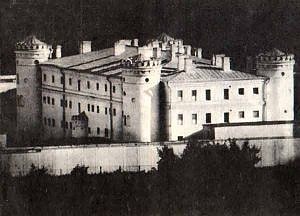
Also known as: Пішчалаўскі замак
Prison in Minsk, Belarus. The Minsk Detention Center No. 1 (SIZO No. 1, Russian: СИЗО №1, Belarusian: СІЗА №1 informally known as Valadarka is the central prison of the Republic of Belarus located in Minsk.[35]